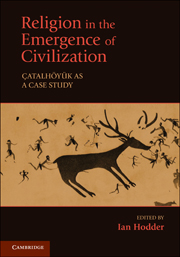Book contents
- Frontmatter
- Contents
- List of Figures and Tables
- Contributors
- 1 Probing religion at Çatalhöyük
- 2 The symbolism of Çatalhöyük in its regional context
- 3 Spiritual entanglement
- 4 Coding the nonvisible
- 5 Modes of religiosity at Çatalhöyük
- 6 Is there religion at Çatalhöyük…or are there just houses?
- 7 History houses
- 8 Marked, absent, habitual
- 9 Temporalities of “religion” at Çatalhöyük
- 10 The Neolithic cosmos of Çatalhöyük
- 11 Magical deposits at Çatalhöyük
- 12 Conclusions and evaluation
- Index
- References
6 - Is there religion at Çatalhöyük…or are there just houses?
Published online by Cambridge University Press: 05 June 2012
- Frontmatter
- Contents
- List of Figures and Tables
- Contributors
- 1 Probing religion at Çatalhöyük
- 2 The symbolism of Çatalhöyük in its regional context
- 3 Spiritual entanglement
- 4 Coding the nonvisible
- 5 Modes of religiosity at Çatalhöyük
- 6 Is there religion at Çatalhöyük…or are there just houses?
- 7 History houses
- 8 Marked, absent, habitual
- 9 Temporalities of “religion” at Çatalhöyük
- 10 The Neolithic cosmos of Çatalhöyük
- 11 Magical deposits at Çatalhöyük
- 12 Conclusions and evaluation
- Index
- References
Summary
A cautious introduction
On what expertise can a social anthropologist draw that might be useful for the interpretation of an archaeological site such as Çatalhöyük? When facing that question, the anthropologist must accept the uncomfortable fact that he or she has probably much less relevant expertise than the professionals already working, either directly or indirectly, at the site. Not only do they use wonderful techniques in order to obtain data from the remains they uncover, they have also been trained in interpreting their findings with a good deal of theoretical sophistication, which is the fruit of the history of their discipline. Furthermore, they dispose of much more expert general knowledge about the geographical and historical context. They therefore know best how to squeeze interpretation from their material. The social anthropologist coming into such a project will, simply because he or she is innocent of the history of archaeology, run the risk of appearing a blundering, ignorant amateur who, as amateurs often do, simply repeats the mistakes of the past that the discipline has subsequently and painfully learned to avoid. Thus, is not a social anthropologist, let loose on a 21st-century archaeological site, likely to simply prove to be a 19th-century archaeologist in matters of interpretation? The risk is great. The amateur's temptation to attribute fanciful meaning to this or that aspect of the findings on the basis of undisciplined analogies is evident. Characteristic of such mistakes is the assumption that features, or objects, that look vaguely the same as those used by contemporaries must have had similar associations in the past.
In order to avoid the worst pitfalls of this sort of jaunt in another discipline, a severe self-examination on the part of the anthropologist seems therefore necessary. He or she must ask: What might I bring to the process of interpretation that others cannot do better? In what way can I avoid incompetent or misleading attributions of meaning? The answers must come from what the anthropologist can pretend to know better than the archaeologists. In my case I have tentatively two things to offer. First, a theoretical approach that I consider might be helpful even though it is not widely shared and, second, detailed knowledge of a couple of contemporary societies and cultures in Madagascar.
- Type
- Chapter
- Information
- Religion in the Emergence of CivilizationÇatalhöyük as a Case Study, pp. 146 - 162Publisher: Cambridge University PressPrint publication year: 2010
References
- 22
- Cited by



